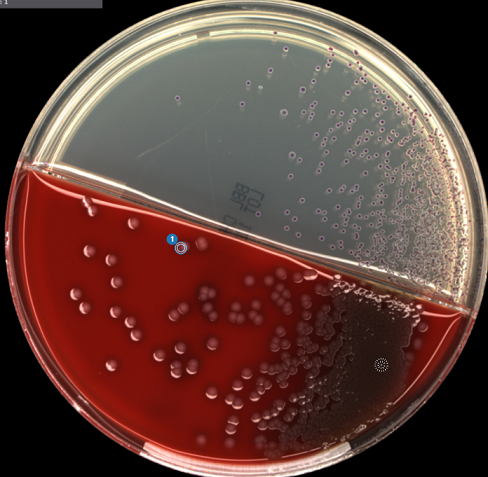Name that organism!
BD's BBL CHROMagar series is one of the most useful tools when doing microbiology. It's a nonselective, differential media. This means you can grow most bacteria/yeast and they grow in their unique ways on the agar. In this case, the differentiation lies in the colors they appear.
This agar is often the go-to for urine cultures. The CHROMagar helps the lab choose quicker workflows to identify and perform susceptibilities. Since most urinary tract infection (UTI) usually involve only one organism, it helps out a lot.
This agar is not recommended for routine wound or even respiratory cultures. They tend to contain multiple organisms and will turn your agar into a color palette mess.
To read more about it, here's a LINK to BD's product.
As mentioned, different organisms appear in their unique ways on the agar. Here are two pictures that depict what a pathogen looks like on day 1 and then on day 2.


For those of you who may have had experiences with CHROMagar, the first image may look like E. coli. But, the size of the colonies and tone of the color seem off. That's because it's not E. coli. This is evident once we look at the image on day 2 when you look at the blood agar side of the biplate.
Question of today will be:
What is the organism pictured above?
Here are the clues:
This is an uncommon pathogen in the US, especially in landlocked states like Utah. A feature of this organism is that the susceptibility testing involves saline. This is also a pathogen we would look for in a stool culture.
Good luck!
Posted with STEMGeeks
I will name it: DAVE
Hmmmmm
Isn't that the name you use as your "alter"?😏
@enforcer48, I have no flipping clue what this is, so I'm out of guesses (this is way, way out of my knowledge base, but cool thing you're doing here). Sure looks creepy unpleasant.
Believe it or not, I don't see this specific bacteria very often.
I gathered that based on what you said in your post. It made me curious enough to go searching to see if I could figure it out (even though I know nothing). I gave up. It's like a foreign visual language to me, lol.
I will try to construct less specialized ones in the future.
I will try harder to figure out what it is in future. Maybe I can learn something that way. 😁
Hello @bluerobo
This is my own !BEER
Have fun with it!:)
You need to stake more BEER (24 staked BEER allows you to call BEER one time per day)
He said poop!:)
!BEER
View or trade
BEER.Hey @enforcer48, here is a little bit of
BEERfrom @isnochys for you. Enjoy it!Learn how to earn FREE BEER each day by staking your
BEER.A little beastie from Sri Lanka?
No.
Hi @enforcer48 ,I will be honest, I see this and I feel chills, I imagine the pain that people who have this suffer, I don't know the answer to your question, but I admire the people who observe all this in a laboratory, I think that not everyone could do it, well I don't could do it .
Yeah, this one was definitely not that pleasant for the patient.
Its name is @adamada
If only.
I haven't had my morning coffee yet but I will come back to this. Group D enterococcus spp just from the buzz word saline and stool.
Enterococcus faecalis
I wager @therealflaws' left testicle.
Enterococcus species are usually blue on CHROMagar.
And they are rather common UTI pathogen.
Proteus, Morganella and Providencia Group.
Not sure if it will appear the textbook swarming if given more time to grow or that is already a swarming growth pattern so I'm leaning on to Proteus mirabilis.
Proteus is beige on CHROMagar.
Take a step back and read the clues again.
My first guess before E. faecalis was S. bovis
Buzz words like landlocked made me weirdly associate it to the word "cattle", there's no rationale why it just is. It's the same feeling when someone mentions penicillin and I think of oranges but never the other way around.
Then the word saline which is used at 6.5% NaCl growth to test between Enterococcus spp and S. bovis. This is all not factoring in CHROMagar. I'll read on it further.
S. bovis is also blue on the agar, but they have a different appearance compared to Enterococcus.
The organism in question is gram negative.
Yersinia enterolitica
Nope.
Yersinia pestis
Am I even getting close?
No. Colder.
Think waterborne.
Ok, before even coming up with Yersinia enterolitica, there was Aeromonas hydrophila but stool cultures and landlocked buzzwords made me not mention it first not being a common uropathogen.
Unfortunately, it's not Aeromonas, but that is more in line with stool, waterborne, etc.
Now, try salt water instead of fresh water.
V. parahaemolyticus or V. vulnificus
Correct genus!
I thought of Vibrio cholerae before resorting to parahaemolyticus or vulnificus.
Few more comments into the future of getting this possibly wrong would have me guessing V. mimicus or V. alginolyticus just to cross off some list under the Vibrio genus.
And V. cholerae is the correct answer.
I have never seen what it looks like on the CHROMagar before this case.
This was fun, got me reading more about CHROMagar. I'm focused on the surgicopath side of things so subjects like microbio, clinical chem, and hematology will be a new exposure as my rotations were shifted recently.
Glad you enjoyed it.
Microbiology is definitely not for me. I have no clue about anything in this picture... How do you manage to get ideas at the end? Is it simply related to experience or are there special tricks that help to point in this or that direction?
It's all about process of elimination aided by tools.
I guess particle physics tools won't help here :D
Probably not. Molecular tools are probably as high end we need to go.
Thanks for your contribution to the STEMsocial community. Feel free to join us on discord to get to know the rest of us!
Please consider delegating to the @stemsocial account (85% of the curation rewards are returned).
You may also include @stemsocial as a beneficiary of the rewards of this post to get a stronger support.
Is this disease fatal?
It can be if left untreated.
THank you
It only grows in blood culture?
No.
And the answer is Vibrio cholerae.
This was the first time I had ever seen it grow on CHROMagar.
@Adamada got it!